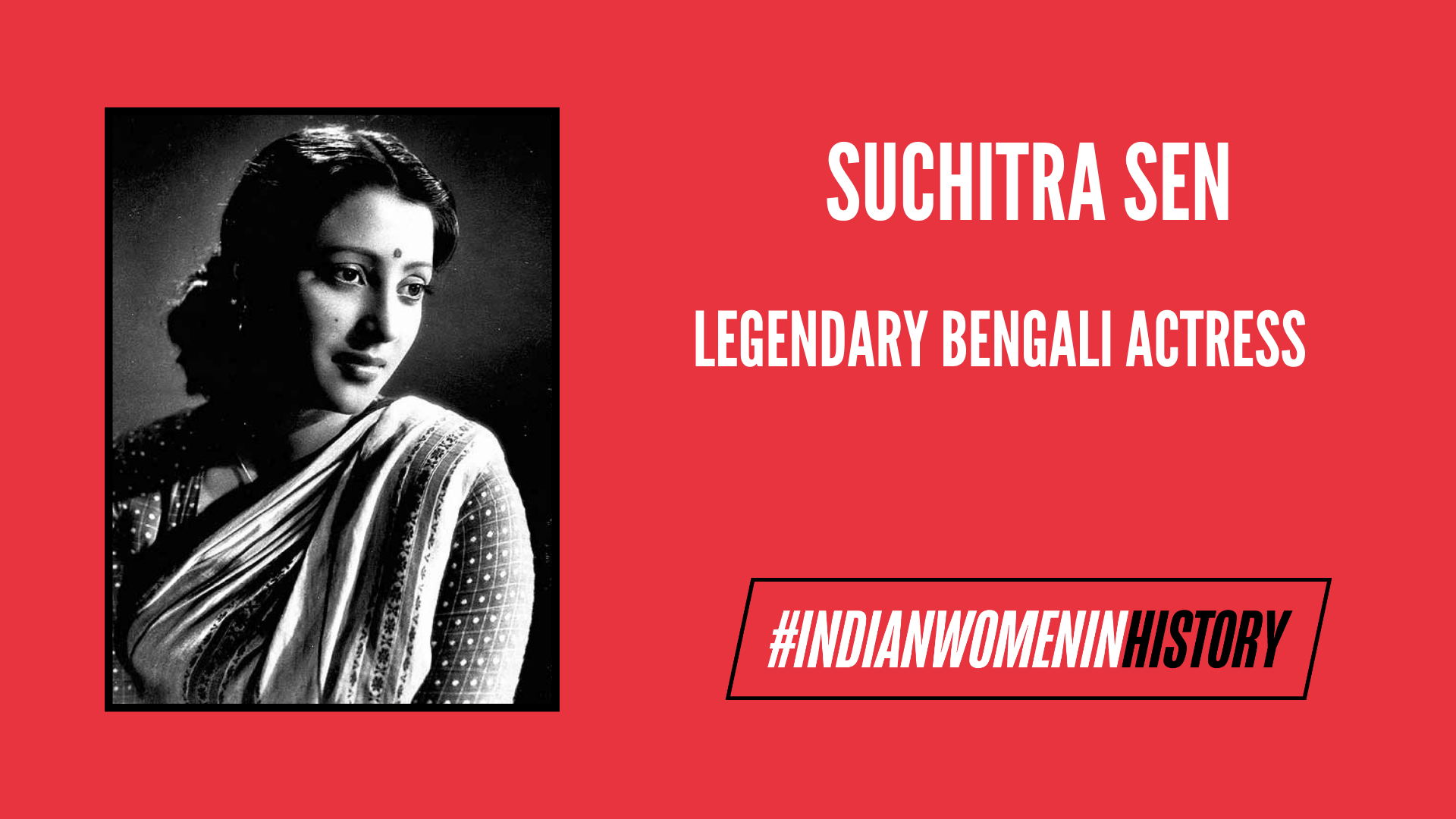The dusky, svelte beauty with dark eyes and a bewitching smile, strode into the silver screen like Colossus. Her vivid, romantic acting sent the viewers into a tizzy. Her scintillating performances gladdened millions of hearts. This was Suchitra Sen, one of the stalwarts of India’s tinsel town.
Early Life
She was born as Roma Dasgupta, on 6th April 1931, in Pabna (present day Bangladesh). She finished her schooling at the local high school. Due to the Partition of 1947, the family migrated to West Bengal. That same year, she entered into an early marriage with Dibanath Sen, son of noted industrialist Adinath Sen.
Marriage, motherhood and career
Dibanath reportedly discovered his wife’s acting potential early in their conjugal life. He encouraged her to carve out a career for herself. He roped in renowned film director Bimal Roy, whose late sister had been Adinath Sen’s first wife. Roy introduced her to another contemporary director Sukumar Dasgupta.
He put her through a screen test before launching her in his film Saat Nombor Koyedi. One of Dasgupta’s assistants gave the fledgeling actress her screen name ‘Suchitra’. In 1953, she had signed many other films such as Kajori, Sharey Chuattar, and Bhagawan Sri Sri Krishna Chaitanya.

With daughter Moon Moon and husband Dibanath. Image Credit: The Daily Star
Her only child Moon Moon Sen was born in 1954. The gutsy actress managed to efficiently juggle domestic life and motherhood with her film career.
Turning Point
The turning point in her career came with Sharey Chuattar. The hilarious film was a box office hit. Most significantly Uttam Kumar, who had made his debut in the film, had been successfully paired with Suchitra. From this point, there was no looking back for either of them.
The iconic duo
Over the next twenty years, the duo dominated Bengali cinema. An interesting fact: out of the 60 films in which Suchitra Sen starred, 30 had Uttam Kumar as the hero/protagonist. In fact, Uttam Kumar became the heartthrob of the masses in tandem with the romantic and melodramatic Suchitra Sen.

Uttam Kumar and Suchitra Sen. Image Credit: News 18
Their milestones include Har Mana Har, Indrani, Chaawa Paawa, Shapmochan, Suryatoran among many others. Their films entailed jam-packed cinema halls. During the 50’s and 60s, serpentine queues for procuring tickets in advance was a familiar sight. The immense popularity of this legendary pair created a benchmark in the Bengali film industry, which remains unchallenged till date.
Also Read: Binodini Dasi: Trailblazer In Bengali Theatre | #IndianWomenInHistory
Sen tasted international success in 1963 when she won the Best Actress award for Saptapadi at the Moscow International Film Festival. She was the first Indian actress to do so! Another of Sen’s memorable movies was Uttar Falguni. In it, she played the dual role of courtesan Pannabai, and her barrister daughter Suparna. She won many accolades for portraying the quintessential mother willing to perform the greatest sacrifice possible in order to give her offspring a dignified life.
Suchitra Sen and Soumitra Chatterji
Another landmark film Saat Paake Bandha catapulted Suchitra into the limelight again. In the film, she acted opposite Soumitra Chatterjee. Suchitra depicted the agonies of a young wife torn between her idealist husband and her rich, domineering mother.
The climactic scene of the film where (as Archana) she rips off her husband’s vest in a moment of glory, remains perpetually etched in the minds of her fans. The film bagged another award at the Moscow Film Festival.
Suchitra Sen in Bollywood
The actress found a foothold in Bollywood with the help of Bimal Roy who cast her in his blockbuster film Devdas, based on Sarat Chandra’s famous Bengali novel of the same name. She was lucky to share screen space with superstars like Dilip Kumar and Vaijyanthimala. However, she made her own mark with her grace and immaculate style.

As Paro in Bimal Roy’s Devdas. Image CRedit: Times of India
She also starred in Bombai Ka Baboo opposite the popular, evergreen Dev Anand. Her most famous Hindi film was Gulzaar’s Aandhi revolving around the political and personal life of a woman politician. A huge controversy erupted because the storyline bore an uncanny resemblance to the life and career of Prime Minister Mrs Indira Gandhi.
She won a nomination for Best Actress for her sensitive role in the film. By a quirk of fate, she never got an opportunity to work in the films of the Titans of parallel Bengali cinema e.g. Satyajit Ray, Ritwik Ghatak and Mrinal Sen. Though Ray had once taken the initiative to cast her, yet things did not work out.
In 1972, Suchitra Sen was bestowed with the prestigious Padmashree award.
Disharmony and personal tragedy
It is believed that although Dibanath had initially helped to launch his wife’s career, yet her growing popularity and celebrity status made them drift apart. In November 1969, Dibanath died in a car accident in the US.
Following the disaster, the actress slipped into self-imposed oblivion, detaching herself completely from public appearances and contacts. Consequently, film aficionados began comparing her with Greta Garbo, the enigmatic Hollywood star.
To preserve her obscurity, she refused the prestigious Dadasaheb Phalke Award in 2005. Following a heart attack on 17th January 2014, Suchitra Sen walked into the sunset. Till date, the elusive mysterious lady lives on in the hearts of millions of her fans!
Also Read: Iqbal Bano: The Pakistani Songstress Who Sang Of Revolution
About the author(s)
Delhi based Ruchira Ghosh is a trained journalist with nearly two & a half decade’s writing experience and exposure to print, web and television.





I loved her performance in Aandhi. Had great chemistry with Sanjeev Kumar. Aandhi is a must watch feminist film.
“She was lucky to share screen space with superstars like Dilip Kumar and Vaijyanthimala. However, she made her own mark with her grace and immaculate style.” Why do I find this part problematic and demeaning?